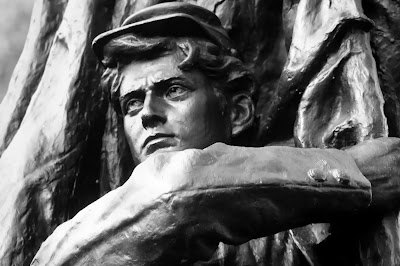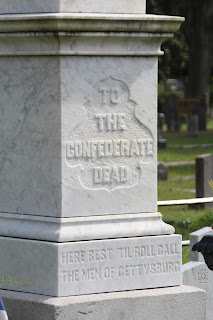It is often said, although with questionable authenticity, that the Cherokee called the creek which runs through Walker County in Northwest Georgia, “Chickamauga” or “The River of Death.” That moniker seems all too intuitive and only fitting for during this week a century and a half ago, the Union Army of the Cumberland and the Confederate Army of Tennessee pommeled, battered and slaughtered each other in the foothills of the Appalachian Mountain Range.
Nearly everyone has heard of the Battle of Gettysburg in July 1863. In that horrific and climactic three-day battle, casualties were estimated from 46,000 to 51,000 or nearly 17,000 per day. Many people don’t realize it, but the second bloodiest battle of the Civil War took place right here in Georgia.
In two days, September 19 and September 20, 1863, the two armies counted roughly 35,000 casualties. Nearly four thousand (1,657 USA, 2,312 C.S.A.) men would die on the battlefield or in nearby field hospitals. More than 24,000 (9,756 USA, 14,674 C.S.A.) were wounded during the two days of fighting. Another six thousand or more men were listed as captured or missing with the Union Army accounting for three quarters of that amount.
For the most part, Laurens Countians served in the Army of Northern Virginia and another configuration of the Army of the Tennessee. Slightly more than a half dozen Laurens Countians took part in the second most deadly battle of the Civil War.
The highest ranking Laurens Countian to take part in the battle was Col. William H. Wylly. Wylly, then a captain and later a Dublin lawyer, was in command of Company A of the 25th Georgia Infantry. Attached to Wilson’s Brigade of Wm. H.T. Walker’s Division, the 25th, which had seen only coastal duty until that time, was engaged in the fighting at the northern end of the battlefield. Capt. Wylly made it through the battle unscathed. George M. Prescott, a member of the Brown Light Infantry of Screven County, but later a long term resident of Laurens County, also made it through the fighting virtually free of injuries.
The majority of the local men who saw action at Chickamauga were members of the 20th Georgia Volunteer Infantry. The 20th Regiment, under the command of Gen. Benning’s Brigade, saw little fighting as they were used in reserve during the vicious crisscrossing combat along the LaFayette Road. Young Woodard Swinson, one of the county’s first men to volunteer for Confederate service, joined the Muscogee Mounted Guards on May 23, 1861. Swinson survived the fighting, only to be killed at Deep Bottom, Virginia eleven months later.
George W. Belcher, who would later become Police Chief of Dublin, joined the Jefferson County Guards in 1861. Sgt. Belcher was wounded in the Seven Days Battles and at the Second Battle of Manassas in 1862. Belcher survived the hellish fighting at the Devil’s Den at Gettysburg as a member of Gen. John B. Hood’s Division under corps command of Gen. James Longstreet. Longstreet’s Corps, which had suffered brutal casualties at Gettysburg, had only eleven weeks of rest before going into the cataclysmic combat at Chickamauga.
Sgt. Belcher, of Company C, was severely wounded in the fighting, probably between the Brock House and the Log School east of Lafayette Road. He recovered and returned to his company which surrendered with General Lee at Appomattox. Chief Belcher died in 1911 and is buried in Northview Cemetery.
 James McLeod, who briefly lived in Laurens County at the turn of the 20th Century, was a member of Company B from Telfair County. McLeod survived most to the war unscathed until he lost the sight in one eye at Appomattox Court House, a day before the surrender.
James McLeod, who briefly lived in Laurens County at the turn of the 20th Century, was a member of Company B from Telfair County. McLeod survived most to the war unscathed until he lost the sight in one eye at Appomattox Court House, a day before the surrender.
Walter T. Dawson, a private in Gist’s Brigade, Walker’s Division, was wounded in an eye and lost his sight in the heavy fighting along the northern end of the fighting.
James F. Hawkins, of the Hancock County Guards, was a member of Benning’s Brigade. Pvt. Hawkins, who moved from Washington County to Laurens County, in 1900, was wounded in the left shoulder at Cold Harbor in June 1864.
Maj. Gen. William Rosecrans launched an offensive from Chattanooga down into the northwest corner of Georgia against Gen. Braxton Bragg’s forces to drive Bragg’s army out of that strategic Tennessee fortress. Bragg wasn’t going to give up so easily and moved north to meet Rosecrans.
After skirmishes between infantry and cavalry on September 18, the real killing began the next day. Longstreet’s Corps attacked and drove a large part of the Union Army off the battlefield. The Federal Army held onto their tentative defensive position, while Confederate units attacked Chattanooga from its neighboring heights on Lookout Mountain.
The brutal fighting started just after dawn on the 19th. Bragg’s forces made repeated charges against the Union right with some successes. Determined Union defenders held strong. Just before midnight, Longstreet’s two divisions, with six fresh brigades, arrived on the scene, switching the advantage of the attack to Bragg.
With Longstreet’s Corps on the left and Polk’s corps on the right, Bragg launched a decisive blow to the entrenched Federals. Rosecrans’ mistaken order to fill a gap in the Federal line, resulted in a move which in fact created a fatal gap into which Gen. Hood poured eight brigades, forcing a total collapse of the Union right at the southern end of the field.
Union Gen. George Thomas, thereafter known as the “Rock of Chickamauga,” gathered his remaining troops and stood solid against the capture of his entire force. Thomas’ men held their ground against repeated assaults, withdrawing only under the cover of darkness. Neither side had the stomach to fight again on the following day.
The battle resulted in somewhat of a tactical draw. The Southern army remained in control of the heights above Chattanooga. The defeated Federals escaped back to the safety of their former lines, which they held for the rest of the war. Had Bragg decided to pursue the retreating Federals the following day, the casualty count could have surpassed the horrific toll at Gettysburg.
The Battle of Chickamauga was a test for things to come. In the early spring which followed, Gen. William T. Sherman, came down from the hills of North Georgia, attacking and destroying all targets of military value along his way to the rail center of Atlanta. In his “March to The Sea,” that summer and fall, Sherman put the final nail in the Confederacy’s hopes to retain control of the Southern States and making the end of the war a virtual certainty.
ALL PHOTOS BY SCOTT B. THOMPSON, SR., OCTOBER 2012








































